Druk Padma Karpo School, internationally known as Druk White Lotus School, and popular as Rancho’s School (thanks to the movie ‘3 Idiots’), is a supreme example of resilience, courage and grit. Despite confronting severe topographic and climactic challenges that the formidable terrain of Ladakh offers, it has become a name to reckon with not just in India, but also on the international shores. The school has been recognised for its unique educational practices and for being a wholly eco-conscious building, which relies on natural resources, thereby saving unimaginable units of energy. Stanzin Kunzang, who became the youngest woman principal of Druk White Lotus School in 2014, exudes exceptional passion and energy about her school in this interview…

The biggest feature that sets us apart from any other school is that despite being in a very topographically challenged place, we cater to the educational needs of the displaced, nomadic Ladakhi community. The school has more than 380 children who are first-generation learners, since their forefathers had no formal education. So, the Druk White Lotus School is propelling the development of education without looking for financial gain. What matters most to the school is good energy and intention. We are going all out to help our students cope with education. For instance, we help them with remedial classes. All these initiatives require double the effort than any normal school, where children’s parents have been educated at a school. As far as the residential students are concerned, the struggle is twice as hard. They stay back at the hostel so that they come into the arena of education. Let’s accept it, education today is a highly overwhelming commercialised sector. Children from this background can never afford a residential educational setup. The school’s proportion varies greatly. It has nomads as well as the Chaungpas, or the tribal people of Ladakh. I am proud to share that the maximum range of population of Ladakh comes to our school. We are largely a humanitarian school as even the teachers work happily on a low salary.
“The toilets are small in the school and all the waste is collected, covered in sand and turned into manure (consequently bought by farmers) in a pit below. Imagine, the campus has 1000 people, but not a drop of water is used for flushing! We are saving 3600 times the water used elsewhere by not flushing. This, I would say, is a great contribution to the world. Being in the Himalayas, we are conscious of our responsibilities. We are sticking to an eco-friendly way of living. It takes a lot of mental strength to use a toilet like that. Arup Associates, who designed our eco-friendly school, have taken a local design of pits, given it a local turn with a VIP touch. We thus follow a cycle of 100% usage”
 A view of the school
A view of the schoolThe school, founded in year 2001, is the vision of our Guruji, His Holiness Gyalwang Drukpa. Guruji set up the school at the request of the local villagers who had approached him. He envisioned coming up with a centralised school for children belonging to the most far-flung belts, whose parents are nomads. Coming from the hills, they are constantly on the move. The vision has come true with this school, which gives these the exposure they need while also giving them a settled place. The school began with as little as 88 children, and today, the number stands at 840.
The sponsorship comes from various countries of the world, who are responsible for sponsoring each child. They are working under the flagship of His Holiness Gyalwang Drukpa, who runs various humanitarian worldwide programmes. Some of the sponsors attached to our school come through ‘Live to Love’. It has various branches in Singapore, Germany, UK, France and Hong Kong. Other than that, Drukpa Trust London, New Lives-New Beginnings from Dubai, and Himalayan Friends also manage sponsorship programmes. As many as 380 students are sponsored by these bodies.
For many others, the school bears the expenses of these students, while some of them bear their own expenses. Of these 380 students, 360 are residential. The sponsorship aid varies. It could be between Rs.950 to Rs.1,300 per month and we make do with this amount. Needless to say, it is very challenging to make do with such a small amount. For the students who pay their own fee, we keep raising it by 5% to 10% annually for the residential students. The expenses, renovation and upkeep of our world famous building, designed by Arup Associates and ARUP, are looked into by a different sector altogether, called Facilities Management. Also, we are grateful for many people who cut down the luxuries of their own children, such as weekend outing or entertainment, only to be able to help the school financially.
 Photovoltaic panels which suppply electricity to the campus
Photovoltaic panels which suppply electricity to the campusIt’s an outcry nowadays to preserve one’s culture, but the noise is usually made when the traditional culture has almost reached the brink of a collapse. Things are no different in Ladakh, where there is a stress on preserving the Ladakhi culture and striking a lingual balance. There is a conscious effort to keep up with the language because at the end of the day, the mother tongue will always remain a mother tongue. But at the same time, the new generation is getting exposed to a new culture, especially in Leh. However, we are taking this up seriously and trying to bridge the wide gap between modernity and tradition and trying not to lose our native threads. Yet at the same time, let’s accept that for children, it is not easy to wear the traditional dress or take a fancy to traditional food. It holds true for almost everyone and anyone. But we are also trying to bring people back to their roots. With this in mind, we have Wednesdays, which are earmarked as The Native Day. Throughout this day of the week, everyone who is part of the school, whether teachers or students, wear our traditional dress—the Goncha and Sulma. Right from the teachers to the principal, to the students, everyone speaks the native language. The students pack traditional food for lunch. That, however, is a bit of a challenge, as convincing the parents is a difficult job. The morning hours are busy for them as they are in a tussle to send their offspring to school and they like to do up a convenient, easy meal, such as a sandwich. Cooking a traditional dish is an ordeal for them. On this day, we also teach our students one of the mother tongue, the Boti language. However, English remains the primary language at the school, while the national language, Hindi is as important as the mother tongue. The medium of studies is largely English and Hindi. Thankfully, Hindi isn’t a challenge for the students as they watch their favourite cartoons and TV shows in Hindi, such as Shinchan or Chhota Bheem.
Speaking of modernity, we have to keep in mind that we cater to students between the ages of four to sixteen. The modern touch is quite evident in the students’ uniform, which is very smart. There are bows for the girls and ties for the boys. So many people have asked me if I am trying to anglicise the uniform. But my answer is, why not? We are going into the modern times, where it is every child’s dream to look sharp and modern. Every child is fascinated by the thought of it. Besides, English is being promoted greatly in the school. The modern amenities at the school are aplenty—a maths lab, music class, art class, kung fu class. The school has considered the modern aspects of education. This is achieved through the limited quarterly funds that we get from our sponsors.
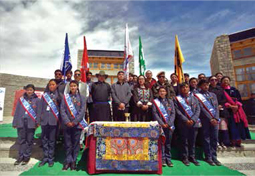 Investiture
InvestitureWe have been honoured for being among the top ten Best Practices Schools in India. For starters, most schools of Ladakh rely on the local language or Hindi, but Druk White Lotus School is an out and out English school as a great emphasis is laid on the language. At our school, there are no backbenchers as we work on ‘think, pair, share’ pattern, wherein we form a group of six to eight children around a table and stoke discussions on various subjects. However, it is challenging to stop the kids from chattering. This practice ensures that everyone is participating equally, also because there is peer pressure too. This also proves to be a great team building exercise, while allowing them to reach higher levels of cognitive development. Children are asked open-ended questions which stokes their imagination, for instance, ‘a thief broke into a house in the middle of the night, why did he kill the dog first?’ It’s amazing how each child has a different perspective on the question!
We also have sister schools in Delhi, such as Sanskriti School and Bluebells School that help us keep up with the syllabus and the books taught. These sister schools also help us train teachers, make sure they have confidence, while also letting us keep abreast with education pedagogies. They impart personal confidence training to teachers and guide us with references for books, worksheets and other education patterns. They have leaders specifically looking into this aspect. It is very generous of them to do that. It is my powerline since it keeps my teachers energised and refreshed at the same time. This practice is greatly helping us bridge the gap between Delhi and Ladakh. So, there is no vacuum, or inferiority. Our team of teachers often visit Delhi schools. As for the students, we try and provide ample exposure to our senior students by taking them on funded national and international tours. About 40 students of Grade X set out on a sponsored travel to places such as Delhi, Nepal, Bhutan and Darjeeling. We have kids who have never sat on a flight in their lives, so this is a good exposure for them. In fact, I have been one such kid, but being exposed to various cultures has made me far more confident. It’s all because I have been exposed at the right time.
Druk White Lotus School is the first school to initiate strong measures for child protection. We have taken help from Cambridge University, UK to seek guidance from them in forming up detailed strong child protection and safeguarding policies. The teachers are sent for trainings for the same. We have also worked with Save The Children India, a worldwide programme.
As a residential setup, our areas of protection are larger. No other school has any such policy. We have international ties on this front with London. Despite several attempts, the school hasn’t got CBSE affiliations, but we haven’t let that come in our way. We follow the J&K State Board.
“We also have sister schools in Delhi, such as Sanskriti School and Bluebells School that help us keep up with the syllabus and the books taught. These sister schools also help us train teachers, make sure they have confidence, while also letting us keep abreast with education pedagogies. They impart personal confidence training to teachers and guide us with references for books, worksheets and other education patterns. They have leaders specifically looking into this aspect. It is very generous of them to do that”
I have various examples to share about that! I have taught here in a temperatue that dips to -22 degrees. The whiteboard would refuse to get erased because the ink would freeze, we still remain undaunted in the face of such challenges. We still continue to take month-long coaching classes to help students prepare for public exams from January 2 to February 2. I’d like to say we are practically thick-skinned! We are resilient because we are naturally made to be like that. That said, the school is known the world over for its reliance on natural resources and the green factor that help us combat these challenges. The school has been designed so well that we don’t feel cold at all in the classrooms. The big glass windows and trombe walls utilise the passive solar energy and keep the rooms warm.
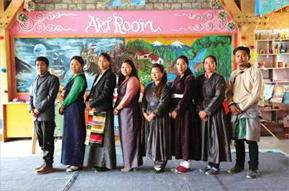 All the teachers
All the teachersThe school is placed in a cold desert area, where there are high wind energy levels. The snowfall is depleting with the global climate change, but the extreme temperatures are the biggest challenge that we confront. However, the unforgiving cold temperatures are combatted through the double trombe wall, glazing and the use of photovoltaic panels for electricity generation. The usage of timber also insulates the building as do the mud roofs. These are key wonders that keep the school warm. We, being in the Himalayas, are also following the VIP latrine culture, which stands for Ventilated Improved Pits. It’s a terminology in architecture. Many countries, such as Australia are now following this environmentally-friendly term. The toilets in the school are small and all the waste is collected, covered in sand and turned into manure (consequently bought by farmers) in a pit below. Imagine, the campus has 1000 people, but not a drop of water is used for flushing! We are saving 3600 times the water used elsewhere by not flushing. This, I would say, is a great contribution to the world. Being in the Himalayas, we are conscious of our responsibilities. We are sticking to an eco-friendly way of living. It takes a lot of mental strength to use a toilet like that. Arup Associates, who designed our eco-friendly school, have taken a local design of pits, given it a local turn with a VIP touch. We thus follow a cycle of 100% usage.
For some reason, Ladakh is a heavily chewing gum-eating place. Everybody from shopkeepers to fishers can be found eating chewing gumit’s a menace! I learnt why Singapore has banned chewing gum. It harms the environment, infrastructure, especially the railway lines. Sometimes, children stick their gums on the sensors. I was amazed by this fact. I decided then and there that once I step back to Ladakh, I am going to motivate my children to believe in the same fact. This has made Druk White Lotus School the first school in Ladakh to be a chewing gum-free school. I would say not eating chewing gum is also a part of developing our children.
We are also keeping the junk food out of the school in order to keep the plastic out. You know, ours is a celebrated green school and we want to continue living that way. It is for this reason that we don’t have a school canteen. I have been asked several times as to why I am not allowing it, and I keep getting offers to. People say the school can get so much money out of a school canteen, but not having one is a conscious decision that I have made. Day students are getting their lunches packed because of that. Thus, you will find no polythene and plastic in the school. They are strictly banned. This has become our culture and we have incorporated this into our everyday lifestyle.
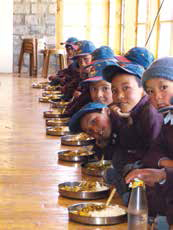 Happy faces
Happy facesEntire India has been hit by the Rancho virus, it seems, which has led people to have the misconception that the school is owned by Phunsuk Wangdu! We are a peace-loving people and were worried about this belief widely shared by people. I’d like to clarify that we have nothing to do with this character called Phunsuk Wangdu. Aamir Khan’s visit though has done wonders for our school. He is a living angel for us. We were already a globally multi-awarded school, but Aamir added the gold gilding by raising its popularity quotient in India. The school has become a touristy point, allowing us to generate funds. There is no entry fee required to pay at the school. But being a souvenir spot helps generate funds to at least meet some of the books’ cost and other maintenance fees. In April 2017 alone, 802 people visited the school at the same time on the same day! There are four escorts who make batches of 30 to 50 people and take them inside the school. There is a special route that takes them to the Rancho’s Point and gets them back. There is also an ‘Idiotic Wall’ in the school inspired by an iconic scene shot there. People have been complimenting our school for the marvellous work and for being eco-friendly. They are fascinated when they come to know I have come from Rancho’s School!
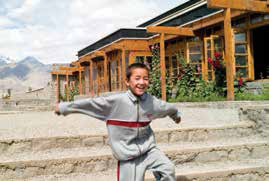
You see, cooking and washing are inevitable things of life, only the way you do it differs. A school is a place where you explore your survival skills in whatsoever conditions. Cooking and washing are an integral part of these skills. In the kitchen at the school, there is no gender discrimination. The school kitchen is literally run by the students of Class VII to X—they are involved in the washing of all the utensils, and cleaning of the kitchen. There are three boys and three girls in the kitchen every day.
I have travelled widely and known people who boast that their kids go to a school that is air conditioned or has an ATM. But how will you teach children when they are fed everything on a platter? What if life changes after their parents? You have to consciously allow them opportunities that make them independent in real, practical life. When children perform these chores like cooking in groups, it helps community bonding. The girls are taught kung fu. Our Guruji is a champion of women’s causes and I am an example of this since I am the youngest principal and a female one.
“It’s an outcry nowadays to preserve one’s culture, but the noise is usually made when the traditional culture has almost reached the brink of a collapse. Things are no different in Ladakh, where there is a stress on preserving the Ladakhi culture and striking a lingual balance”

I live on the campus. For the residential students, the day always begins with a prayer to the Goddess of Wisdom at 6 in the morning. The prayers and meditation last for about 45 minutes. When he is around, the prayers are conducted by the Chairman, His Eminence Skabje Thuksey Rinpoche- (Thuksey translates to ‘The Treasured One’, a title given by us) who is very spiritual. He addresses the children in a 15-minute session. He speaks on issues such as peer pressure, adolescent issues or any other regular challenges that school-going children face. As for the day scholars, the day begins at 9.50 am. They usually stay within a radius of 20 km from the school.
Each day of the week is interesting to say the least. On Mondays, the prayers are followed by a teachers’ talk. On Tuesdays, a senior extempore takes place after the prayers. The students are given a topic to speak on, five minutes beforehand. This is a good way to help them get rid of any stage fright that they may have. Wednesdays are the Native Day. Twenty minutes of traditional prayers are followed by ten minutes of meditation in the school courtyard, which has been given a mandala look to give it a spiritual edge. Thursdays are exceptionally very interesting. A class of 33 to 35 students get to do a presentation, for which the titles have already been given a week before. All the children participate enthusiastically in the form of mimes, news reading, dramatics, quiz, everything rolled into one. Fridays are reserved for junior extempore. It is quite challenging to get small children to speak on the stage. We call Saturdays the multiEach day of the week is interesting to say the least. On Mondays, the prayers are followed by a teachers’ talk. On Tuesdays, a senior extempore takes place after the prayers. The students are given a topic to speak on, five minutes beforehand. This is a good way to help them get rid of any stage fright that they may have. Wednesdays are the Native Day. Twenty minutes of traditional prayers are followed by ten minutes of meditation in the school courtyard, which has been given a mandala look to give it a spiritual edge. Thursdays are exceptionally very interesting. A class of 33 to 35 students get to do a presentation, for which the titles have already been given a week before. All the children participate enthusiastically in the form of mimes, news reading, dramatics, quiz, everything rolled into one. Fridays are reserved for junior extempore. It is quite challenging to get small children to speak on the stage. We call Saturdays the multispecialty day. There is elocution, inter-house and inter-class painting and spelling bees. Our central courtyard is buzzing with activities on the day. You will find one doing painting, and the other one doing the tables, speaking of which, once a parent complained that their offspring was doing fantastically at everything, barring the tables. This gave an interesting spin to our Saturdays, when after assembly, all of the teachers and students started saying the tables. With that, once in a week on a Saturday, every class does an open table mantra. This is effortless learning, where your listening skills can really work out for you. The best thing about our hostel is that there are 20 teachers in the residential area. We work tirelessly on Sundays too to promote personality development.
The students find it hard to keep abreast with technology (because of power network) when compared to other parts of the country. Thus, there is no internet at times and exposure to other resources is also missing. Besides, employers may not want to hire students from the background that our students come from and might choose someone from a metropolitan city over them. But at the same time, I’d like to add that there is no drawback as such. Every person, wherever born, has a reason to be there and you can make yourself worthy. I believe more the challenges, bigger the achievement.
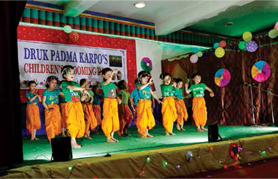 Infant Blooming Day
Infant Blooming DayWe follow the government pattern and thus the winter vacation is from December 15 to March 1. For this time, we give them projects and holiday homework. The projects are assessed as soon as the school reopens. The homework we give our students is not reading or writing-based, but activity- oriented, that requires them to step out of their homes.
We happily engage children from Kindergarten, nursery and Grade I. The little ones love Dholakpur (period) and Joy Park, which have been inspired by the love for Chhota Bheem. Children learn through visual aids, dance, music, book reading. The Joy Park is an animated and lively area for them to play.
We keep a track of all the professions that our children are opting for. We are in the process of forming an alumni club called the White Lotus Club. So far, many of our graduates are in Pune. One of them even cleared the test for IIIT Pune. Many of our alumni prefer non-medical subjects. Many of them are in Delhi and Jammu. Some of them stay back and continue their education in Leh. Largely, everyone wants to become doctor, fashion designer. A lot of them get into Arts. CAs are a scanty number. Many boys join the Indian Army. They also move into tourism. We have designed a special programme for them that allows them to look beyond these white collar professions. The ratio is 50:50 between those who stay back and those who go out of Ladakh to more modern cities to pursue higher education. It depends a lot on the family background too.
I have 17 years of teaching experience. I started out as an accidental teacher and today, I wouldn’t be anything other than a teacher. I love my profession to death. I love it most because I feel it is the best thing in the world to bond with people. The profession allows you to think young, hard, and fresh. Being a divorcee with a 12-year-old daughter and run a school that is world-famous calls for personal sacrifice, courage, energy and motivation. I am of the view that work is worship and it is my work that has got me here. It keeps me going!
By Namrata Gulati Sapra